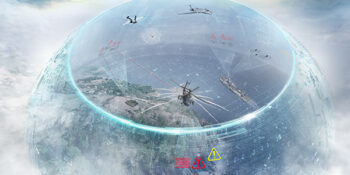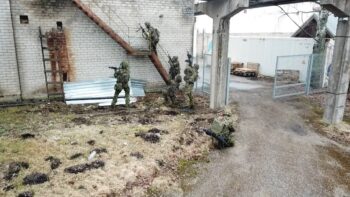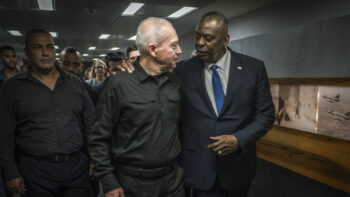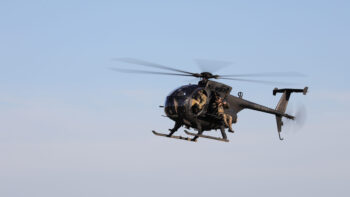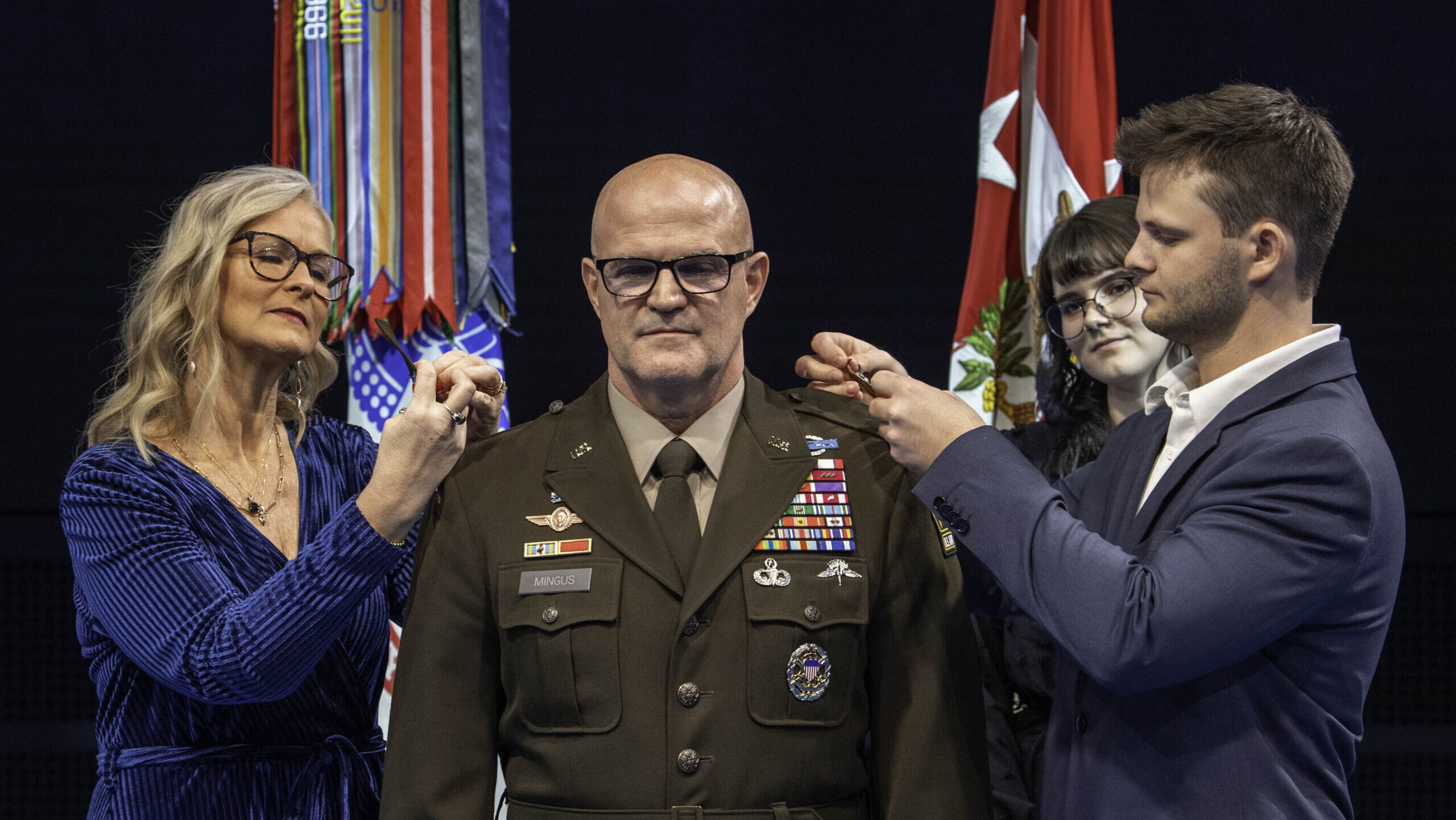
Family members pin a fourth star on the uniform of Vice Chief of Staff of the US Army Gen. James Mingus, center, during his promotion ceremony on Jan. 4. (US Army/Sgt. Deonte Rowell)
CAMP PENDLETON, Calif. — Two months into his tenure as the US Army’s Vice Chief, Gen. James Mingus says he’s settling into his role, and preparing to take a few big swings — including to the Army’s existing network and counter-unmanned plans.
The newly minted four-star general said he has been asked to take on the “traditional role” of running the service day-to-day alongside Army Under Secretary Gabe Camarillo, while Army Secretary Christine Wormuth and Chiefs of Staff Gen. Randy George focus on cultural and leadership issues. As a result, Mingus is poised to have a heavy hand in all technology and acquisition decisions.
“Some of the things the chief has asked me to look at, are some of these directed requirements that he has worked on, counter-unmanned aerial systems and the [command and control] C2 Fix, transform in contact: You know…some of the things he’s really trying to press early on in his time, he’s asked me to help kind of drive some of those things,” Mingus said.
Breaking Defense joined the newly sworn-in four-star general on a trip to Camp Pendleton, Calif. to observe the ongoing Project Convergence Capstone 4 experiment — an event he said is well worth the investment — and to discuss his plans to help transform the Army.
Network Changes Coming With ‘C2 Next’
Mingus enjoys waxing lyrically about the network and command and control, harking back to his earlier days as the Mission Command Center of Excellence director. That includes giving Breaking Defense a preview of looming changes.
With senior Army leaders focusing on the network, Mingus said the plan is for the service to put a new focus on its networks under a pair of new umbrella terms: “C2 Fix” and “C2 Next.”
C2 Fix aims to ensure that soldiers can communicate and fight on today’s battlefield. This is where near-term projects will fall, the kind of capabilities that are already underway. C2 Next, is a prototyping effort the Army is working on with industry in order to experiment with a “data-centric” C2 system, enabled by network transport. The focus is on advanced modular and open architectures, scalability and the ability to quickly evolve and iterate.
Army Futures Command has been working on this plan for months, but at this point C2 Fix and C2 Next are umbrella terms covering various existing and future programs — more similar to the concept of JADC2 than the recently-cancelled FARA helicopter effort. As such, if lawmakers want to make cancellations or investment changes to either umbrella, they will need to do so line item by line item.
“Anytime we’ve got to have a box to talk to a box, we have failed: And we’re still there,” Mingus said on Feb. 28.
When it comes to that box analogy, Mingus cited the Army’s new Integrated Battle Command System (IBCS) as one example of a standalone platform the service is working to integrate other items into. The IBCS, slated for first fielding this year, is billed as a C2 system that will be a centerpiece for the air defense effort. (It also has a growing international footprint, which fits nicely into the Pentagon’s focus on working more closely with allies and partners.)
During this year’s Project Convergence Capstone 4 event, for example, service officials spent time integrating the Terminal High Altitude Area Defense System into the IBCS. They also had the future Indirect Fire Protection Capability Increment 2 (IFPC Inc 2) C2 structure out in California and were also working on integrating it into the IBCS.
After spending the morning of Feb 28 at the capstone experiment, Mingus said he was walking away with several big network takeaways, including reassurance that while the C2 Fix is necessary, the decision to pursue a next generation of C2 systems is critical.
“We’re integrating a lot of things. We’re figuring out how to do things faster as a joint force but until we start to accelerate convergence, common platforms, common messaging, common standards, convergence of data, that’s got to be the next evolution out of this,” he later added.
“That means a common data layer… imagine that you have data convergence. Once you have established that, then you have an agnostic [way] to move the data, whether it’s space, airborne layer, cellular: Now we truly have kind of arrived,” he later added.
Counter-Unmanned Reform
The ongoing war inside Ukraine coupled with the aftermath of the Hamas attack on Israel has showcased the mushrooming threats from aerial drones on the battlefield — to include loitering, one-way attack systems.
During a Feb. 26 Defense Writers Group with reporters, both Wormuth and George hinted that changes may be afoot for how the service and broader Pentagon resources and buys tech to counter those threats.
Wormuth, for example, called for a larger investment and said it is an area ripe for “improvement,” especially inside the US Central Command (CENTCOM) area of responsibility. The Army’s top general, meanwhile, pointed to the growing loitering munition threat to armored vehicle formations and said those combat vehicles need to be “more mobile, smaller, [and the service needs to] figure out active protection that’s around them.”
While Mingus is still settling into his new post, he has been eyeing the growing problem for years, including during his time as first director for operations and then director of the Joint Staff.
“Today, you can buy really good, high-end, unmanned systems that will carry 20-30 pounds,” he said. “So what happens when there’s a commercial demand to move a pallet of wood into your backyard, and move a 500-pound payload instead of a 20-pound payload? That kind of stuff is coming online.”
In the wake of the January attack on Tower 22 in Jordan that killed three Army soldiers, Pentagon officials have been hosting several meetings to decide just what to do and, “We’re on the cusp of probably doing some changes,” Mingus said.
While he didn’t detail the range of options on the table, he said subsequent decisions could alter the current set up, which has an Army-led the Joint Counter-small Unmanned Aircraft Systems Office (JCO) tasked with firming up requirements, materiel and training for joint solutions with the services still buying their own C-UAS.
“We got ourselves organized to get after a lot of things and we have made a lot of progress. But, I think what folks are realizing is it’s probably not moving as fast as it should, given the change in technology,” Mingus explained.
“We’re probably at a crossroads of not, you know, a complete wholesale reorg but how could we reorganize ourselves even a little better than we are now,” he said. “Instead of independent services developing their own counter-UAS, maybe a joint entity that’s working that problem set together, the power of all the services together to try and solve that problem in scale and mass to keep pace.”
Pushing Ahead
Just a few weeks ago, George began touting a new phrase: “Transforming in Contact.”
While he has not released a comprehensive roadmap for implementation, the general idea is to provide deploying/deployed units new technology to test out in real world scenarios. Soldiers and commanders will then provide feedback about which piece of equipment worked well and in which scenarios. This may include things like new C2 Fix capabilities, UAS, electronic warfare (EW) capabilities, new robots, or the Next Generation Squad Weapon.
That push is now on Mingus’ action list and he’s interested to see what works.
One such example is the decision to send four Directed Energy Maneuver Short-Range Air Defense (DE M-SHORAD) prototypes to the CENTCOM region in early February. The project integrates a 50-kilowatt laser onto Strykers to down class 1 to 3 aerial drones and incoming rockets, artillery and mortars. (Kord Technologies was tasked with integrating an RTX laser onto combat vehicles.)
“It’s a prototype, but we want to experiment in a live environment,” Mingus said. “Is it 100 percent ready? Is it going to work perfectly? Probably not, but we’re going to learn from it.”
Service leaders, including the general, are interested in if that 50-kilowatt class laser meets soldier’s needs as is or if the laser’s power needs to be scaled up or down.
“Our high-energy lasers are so susceptible to weather. That’s why I think this is going to be a great laboratory because anytime there’s a dust storm, anytime there’s that kind of thing, it starts to alter the physics of the light particles that actually shoot that beam,” he said.
While technology sharing and program collaboration on things like C-UAS and directed energy does occur between the services, there are vast areas for improvement.
This month, Mingus said he and the other service vice chiefs of staff are kicking off a new round of “service talks” with Air Force Vice Chief Gen. Jim Slife planning to host the first one. (Slife recently alluded to the talks and said data, AI and Combined Joint All-Domain Command and Control are topics of interest.)
While Mingus said this is not a formal process yet, he said it could be an opportunity to kickstart the discussions, before eventually bringing in the service chiefs and secretaries, and also form interservice working groups to tackle specific areas.
“It will mature over time,” he added.
















